TOYOTA COROLLA 2013 11.G Owners Manual
Manufacturer: TOYOTA, Model Year: 2013, Model line: COROLLA, Model: TOYOTA COROLLA 2013 11.GPages: 532, PDF Size: 8.55 MB
Page 241 of 532
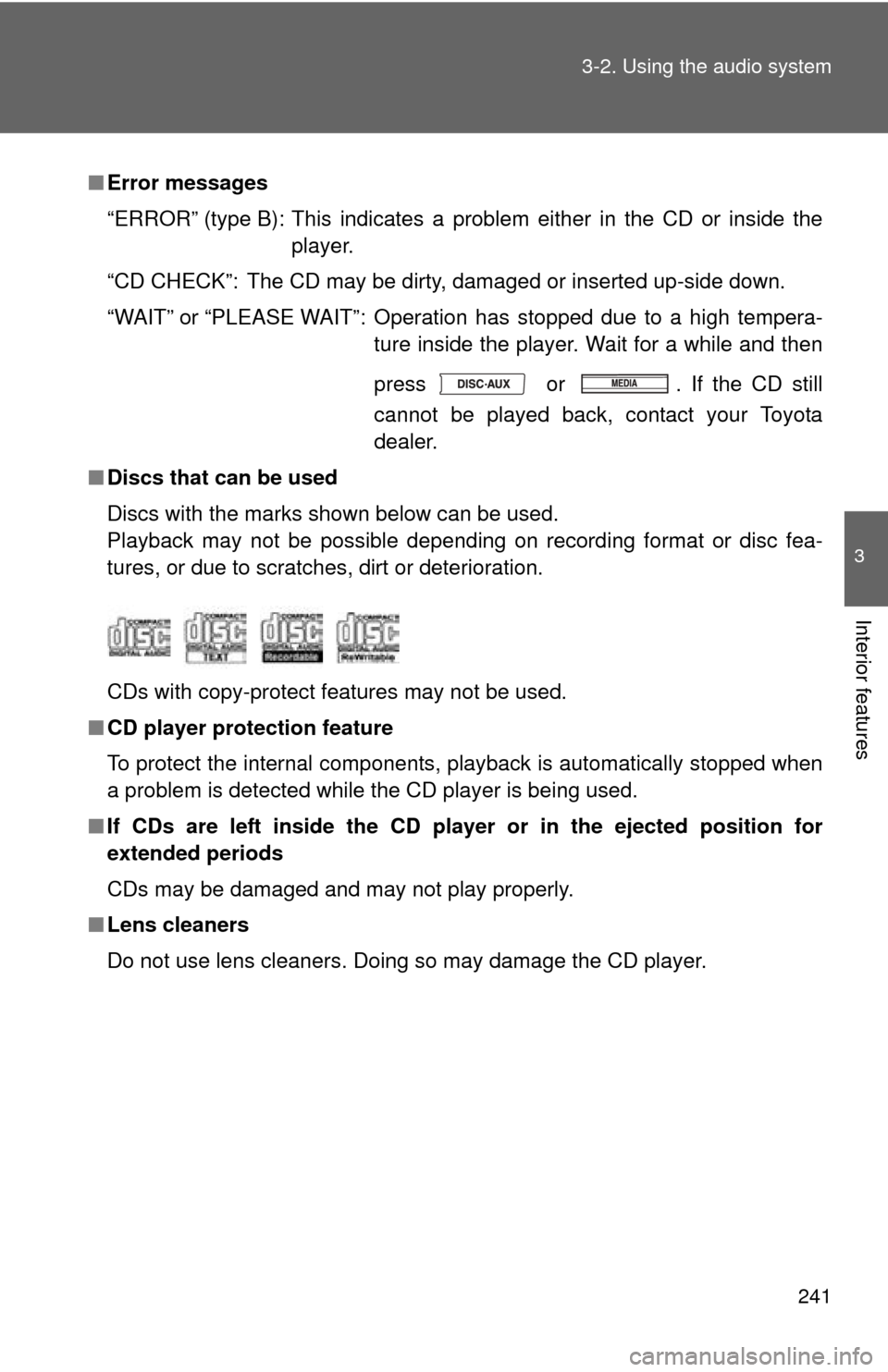
241
3-2. Using the audio system
3
Interior features
Ō¢Ā
Error messages
ŌĆ£ERRORŌĆØ (type B): This indicates a problem either in the CD or inside the
player.
ŌĆ£CD CHECKŌĆØ: The CD may be dirty, damaged or inserted up-side down.
ŌĆ£WAITŌĆØ or ŌĆ£PLEASE WAITŌĆØ: Operation has stopped due to a high tempera- ture inside the player. Wait for a while and then
press or . If the CD still
cannot be played back, contact your Toyota
dealer.
Ō¢Ā Discs that can be used
Discs with the marks shown below can be used.
Playback may not be possible depending on recording format or disc fea-
tures, or due to scratches, dirt or deterioration.
CDs with copy-protect features may not be used.
Ō¢Ā CD player protection feature
To protect the internal components, playback is automatically stopped when
a problem is detected while the CD player is being used.
Ō¢Ā If CDs are left inside the CD player or in the ejected position for
extended periods
CDs may be damaged and may not play properly.
Ō¢Ā Lens cleaners
Do not use lens cleaners. Doing so may damage the CD player.
Page 242 of 532
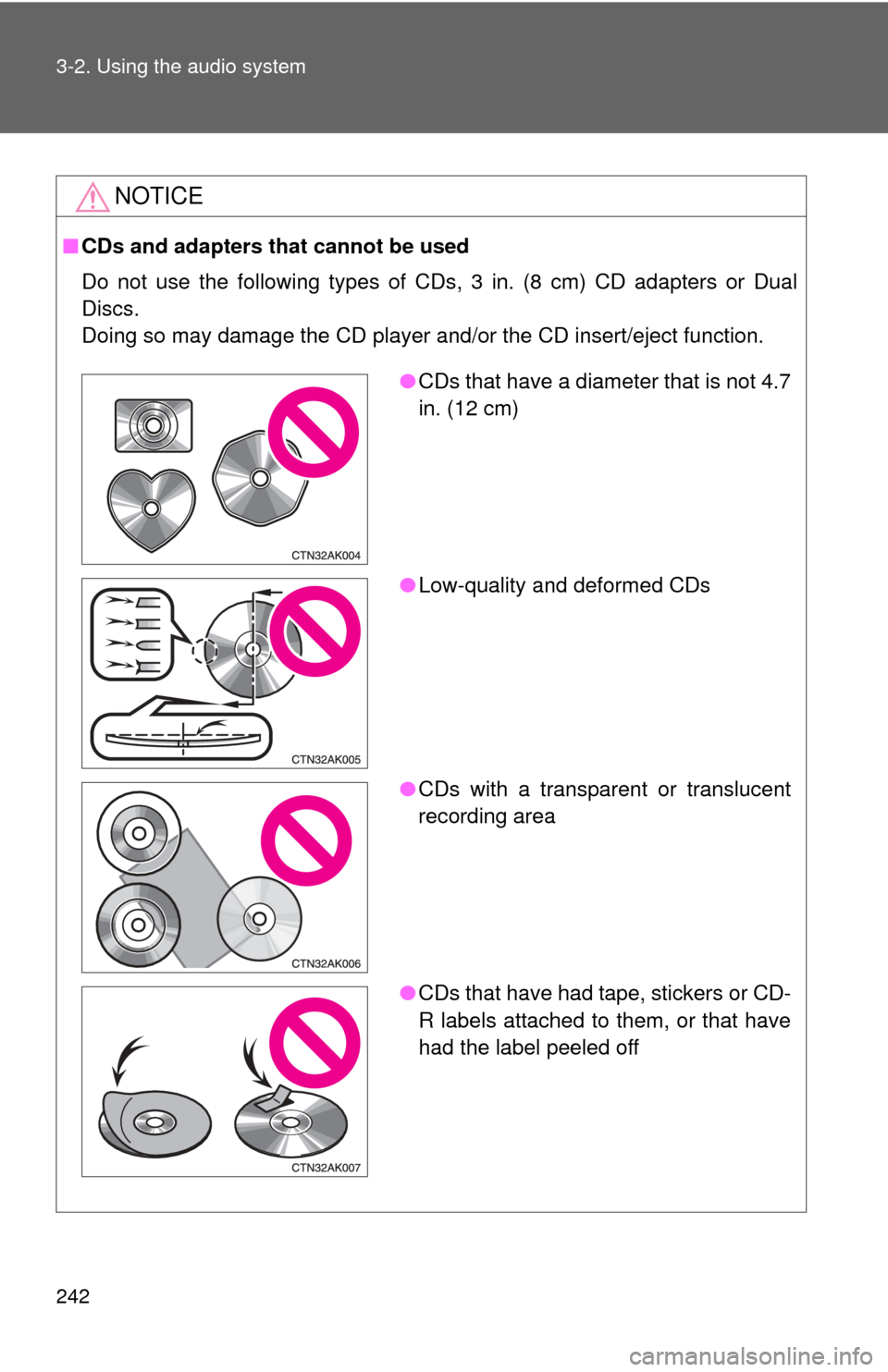
242 3-2. Using the audio system
NOTICE
Ō¢ĀCDs and adapters that cannot be used
Do not use the following types of CDs, 3 in. (8 cm) CD adapters or Dual
Discs.
Doing so may damage the CD player and/or the CD insert/eject function.
ŌŚÅCDs that have a diameter that is not 4.7
in. (12 cm)
ŌŚÅ Low-quality and deformed CDs
ŌŚÅ CDs with a transparent or translucent
recording area
ŌŚÅ CDs that have had tape, stickers or CD-
R labels attached to them, or that have
had the label peeled off
Page 243 of 532
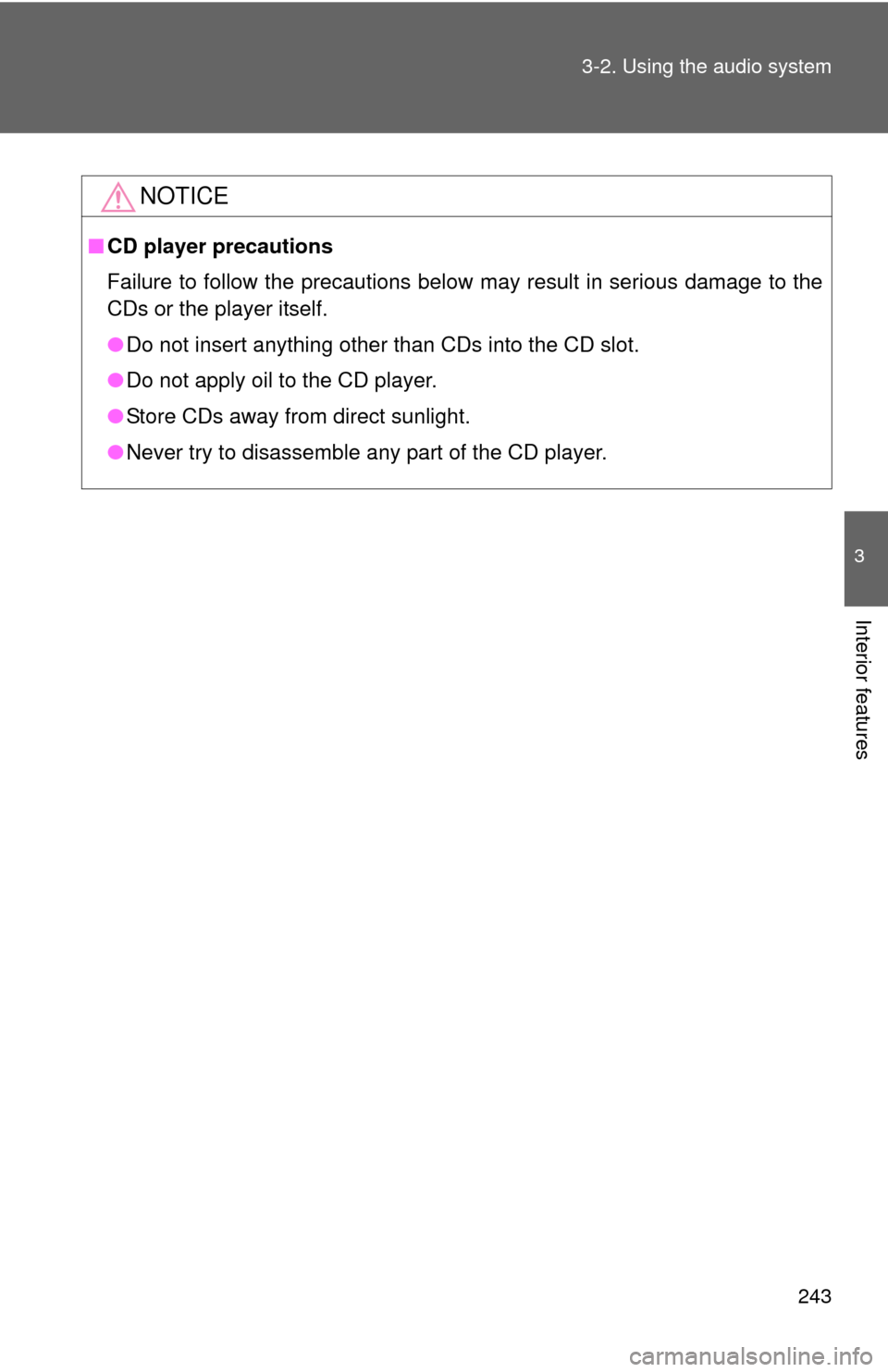
243
3-2. Using the audio system
3
Interior features
NOTICE
Ō¢Ā
CD player precautions
Failure to follow the precautions below may result in serious damage to the
CDs or the player itself.
ŌŚÅDo not insert anything other than CDs into the CD slot.
ŌŚÅ Do not apply oil to the CD player.
ŌŚÅ Store CDs away from direct sunlight.
ŌŚÅ Never try to disassemble any part of the CD player.
Page 244 of 532
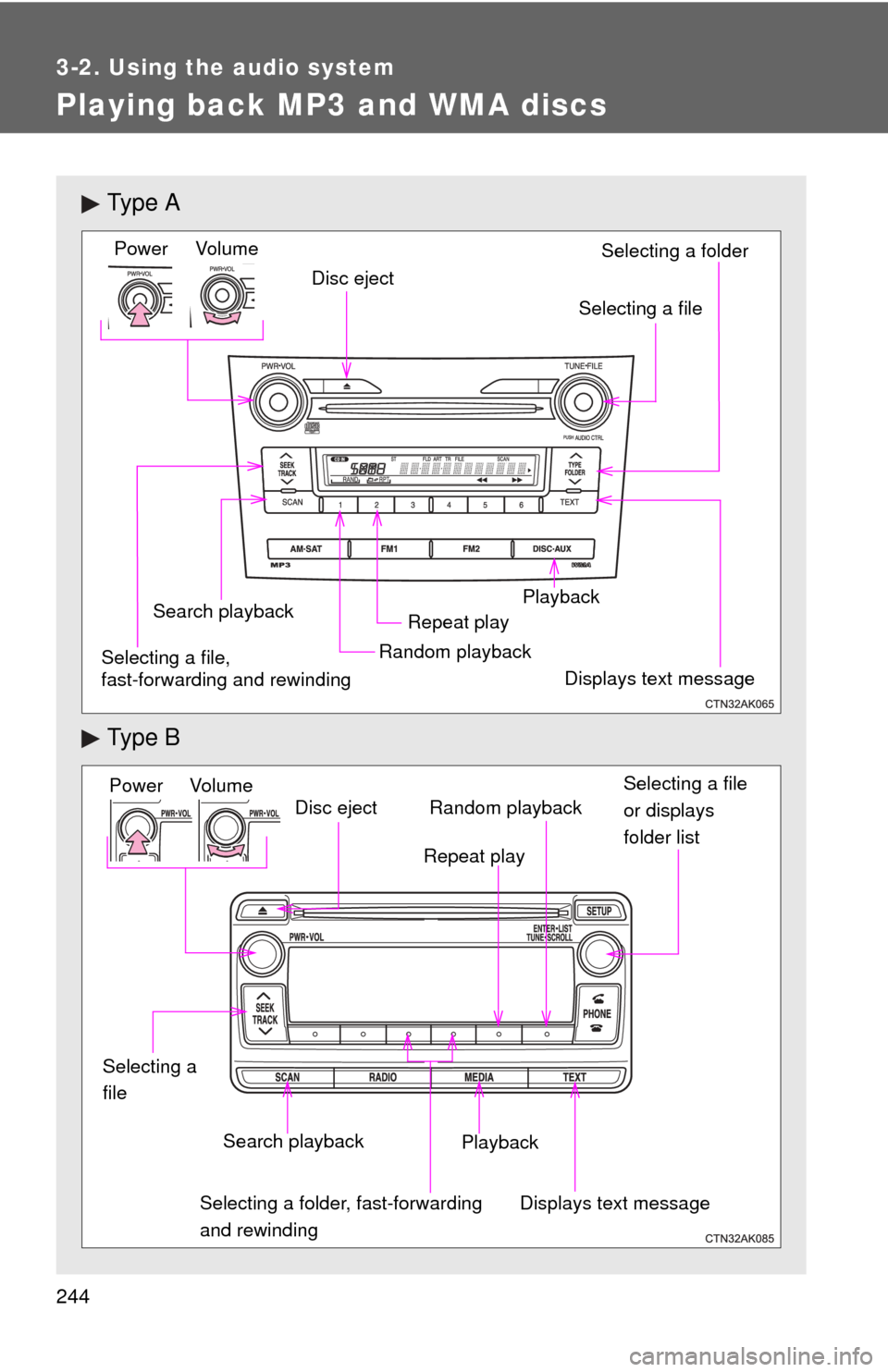
244
3-2. Using the audio system
Playing back MP3 and WMA discs
Ty p e A
Ty p e B
Vol um eRandom playbackRepeat play
Playback
Power
Disc eject
Displays text message
Search playback
Selecting a file
Selecting a folder
Selecting a file,
fast-forwarding and rewinding
Power Volume Search playbackDisc eject
Displays text message
Playback Selecting a file
or displays
folder list
Repeat play
Random playback
Selecting a folder, fast-forwarding
and rewinding
Selecting a
file
Page 245 of 532
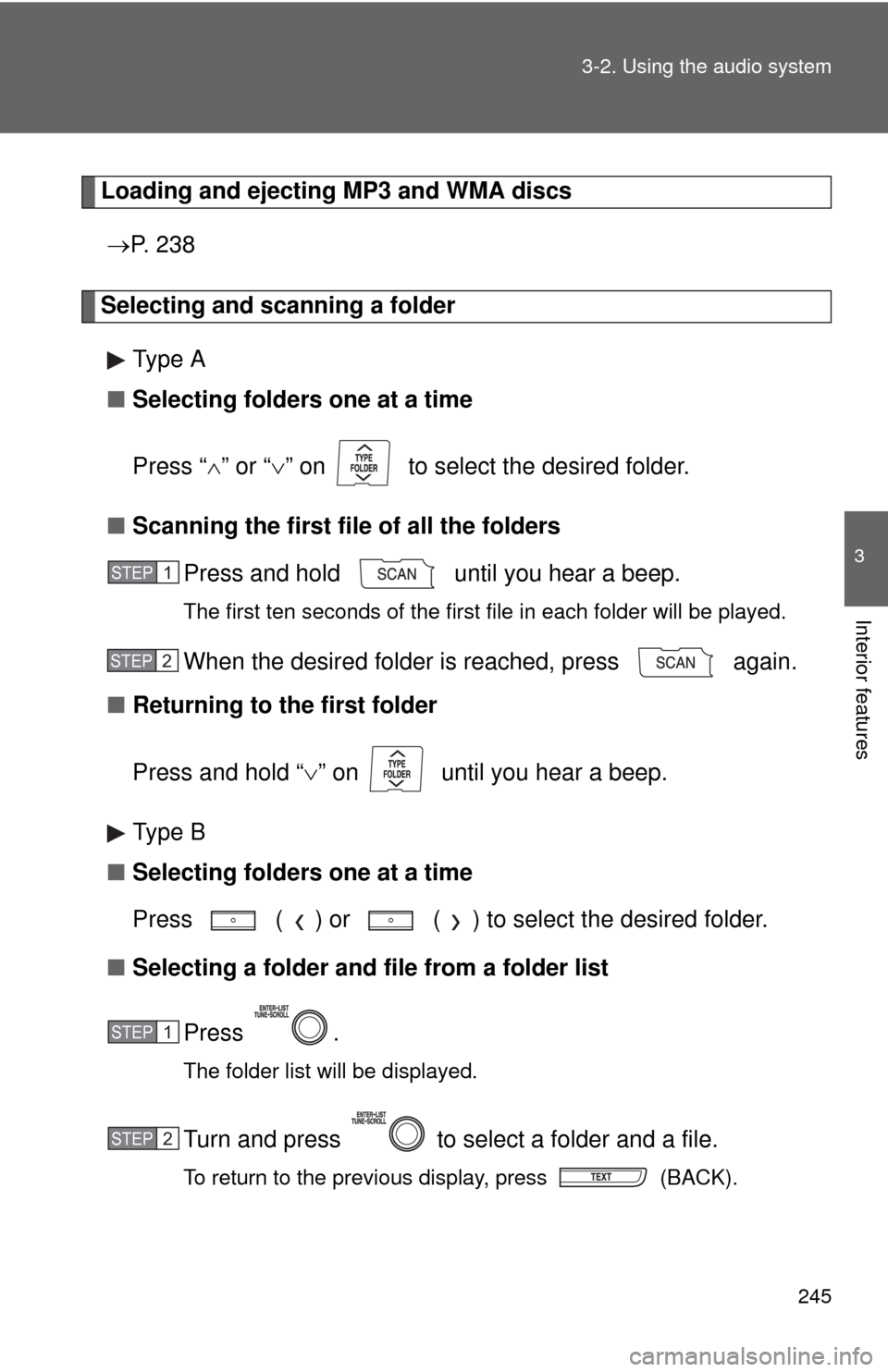
245
3-2. Using the audio system
3
Interior features
Loading and ejecting MP3 and WMA discs
’é« P. 2 3 8
Selecting and scanning a folder
Type A
Ō¢Ā Selecting folders one at a time
Press ŌĆ£ ’āÖŌĆØ or ŌĆ£ ’āÜŌĆØ on to select the desired folder.
Ō¢Ā Scanning the first file of all the folders
Press and hold until you hear a beep.
The first ten seconds of the first file in each folder will be played.
When the desired folder is reached, press again.
Ō¢Ā Returning to the first folder
Press and hold ŌĆ£ ’āÜŌĆØ on until you hear a beep.
Type B
Ō¢Ā Selecting folders one at a time
Press ( ) or ( ) to select the desired folder.
Ō¢Ā Selecting a folder and file from a folder list
Press .
The folder list will be displayed.
Turn and press to select a folder and a file.
To return to the previous display, press (BACK).
STEP 1
STEP 2
STEP 1
STEP 2
Page 246 of 532
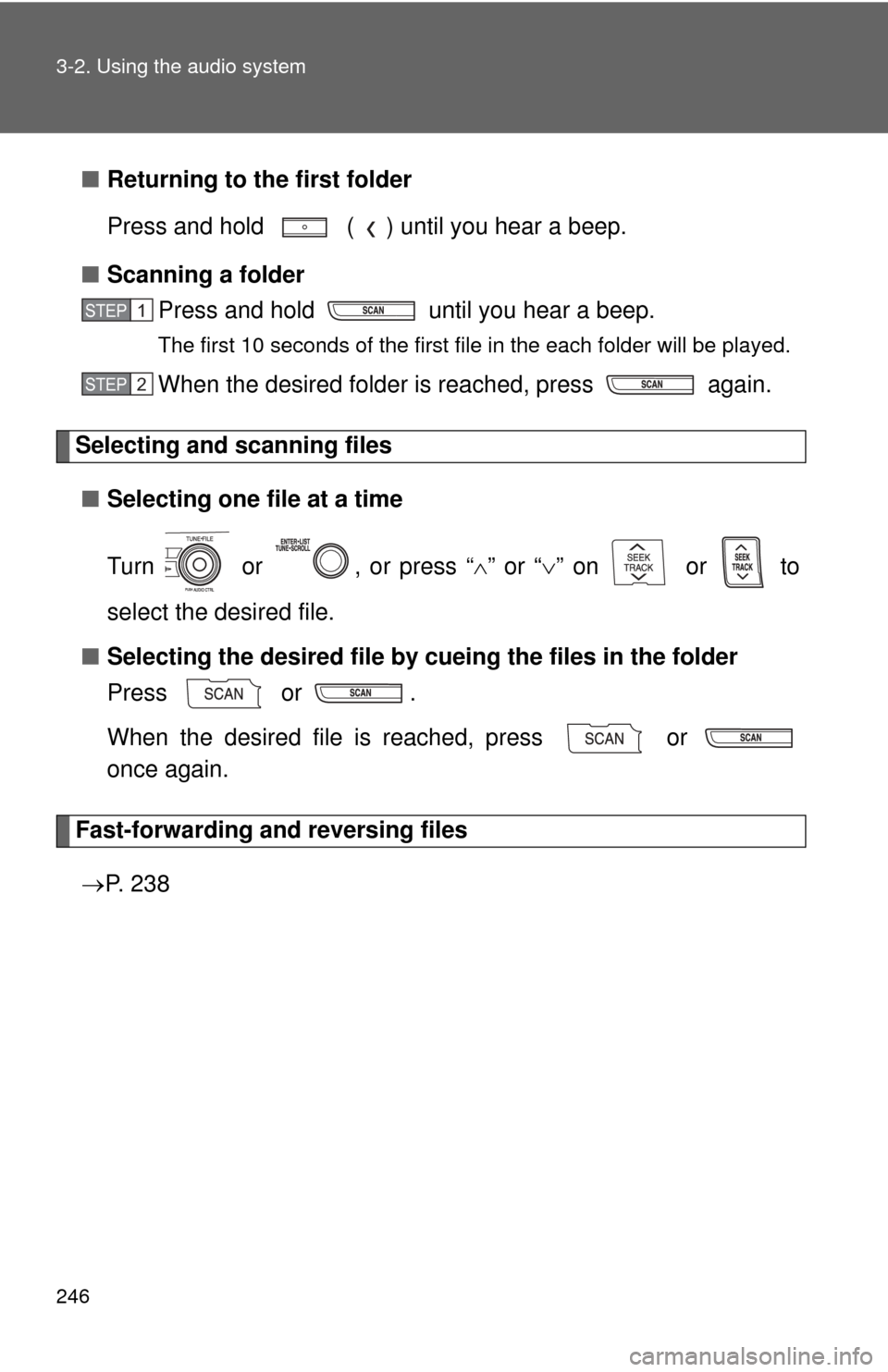
246 3-2. Using the audio system
Ō¢ĀReturning to the first folder
Press and hold ( ) until you hear a beep.
Ō¢Ā Scanning a folder
Press and hold until you hear a beep.
The first 10 seconds of the first file in the each folder will be played.
When the desired folder is reached, press again.
Selecting and scanning files
Ō¢Ā Selecting one file at a time
Turn or , or press ŌĆ£ ’āÖŌĆØ or ŌĆ£’āÜ ŌĆØ on or to
select the desired file.
Ō¢Ā Selecting the desired file by cueing the files in the folder
Press or .
When the desired file is reached, press or
once again.
Fast-forwarding and reversing files
’é« P. 2 3 8
STEP 1
STEP 2
Page 247 of 532
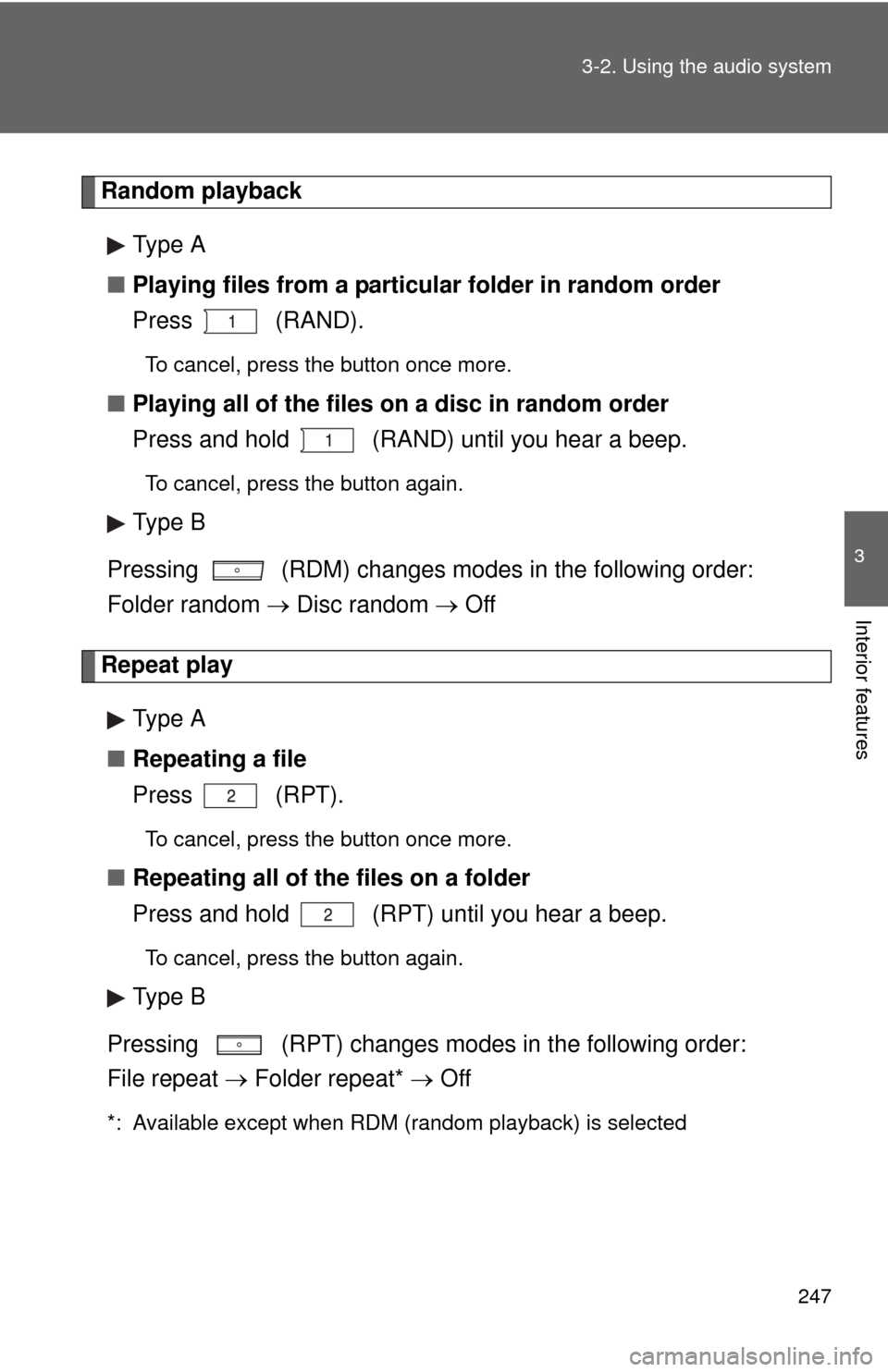
247
3-2. Using the audio system
3
Interior features
Random playback
Type A
Ō¢Ā Playing files from a particular folder in random order
Press (RAND).
To cancel, press the button once more.
Ō¢ĀPlaying all of the files on a disc in random order
Press and hold (RAND) until you hear a beep.
To cancel, press the button again.
Type B
Pressing (RDM) changes modes in the following order:
Folder random ’é« Disc random ’é« Off
Repeat play
Type A
Ō¢Ā Repeating a file
Press (RPT).
To cancel, press the button once more.
Ō¢ĀRepeating all of the files on a folder
Press and hold (RPT) until you hear a beep.
To cancel, press the button again.
Type B
Pressing (RPT) changes modes in the following order:
File repeat ’é« Folder repeat* ’é« Off
*: Available except when RDM (random playback) is selected
Page 248 of 532

248 3-2. Using the audio system
Switching the displayType A
Press .
Each time is pressed, the display changes in the following
order:
Folder no./File no./Elapsed time ’é«’ĆĀ Folder name ’é«’ĆĀFile name ’é«’ĆĀAlbum
title (MP3 only) ’é«’ĆĀ Track title ’é«’ĆĀArtist name.
Type B
Press .
Track title, Artist name and Album title (MP3 only) are shown on the dis-
play.
To return to the previous display, press or (BACK).
Page 249 of 532

249
3-2. Using the audio system
3
Interior features
Ō¢Ā
Display
’é«P. 240
Ō¢Ā Error messages
ŌĆ£CD CHECKŌĆØ: This indicates a problem eit her in the CD or inside the player.
The CD may be dirty, damaged or inserted up-side down.
ŌĆ£NO MUSICŌĆØ (type A): This indicates that MP3/WMA files are not included in the CD.
ŌĆ£WAITŌĆØ or ŌĆ£PLEASE WAITŌĆØ (type A): Operation has stopped due to a high temperature inside the player. Wait for
a while and then press .
Contact your Toyota dealer if the CD
still cannot be played.
ŌĆ£ERRORŌĆØ (type B): This indicates a problem either in the CD or inside the player.
ŌĆ£NO SUPPORTŌĆØ (type B):This indicates that MP3/WMA files are not included in the CD.
Ō¢Ā Discs that can be used
’é«P. 241
Ō¢Ā CD player protection feature
’é«P. 241
Ō¢Ā If CDs are left inside the CD player or in the ejected position for
extended periods
’é«P. 241
Ō¢Ā Lens cleaners
’é«P. 241
Page 250 of 532
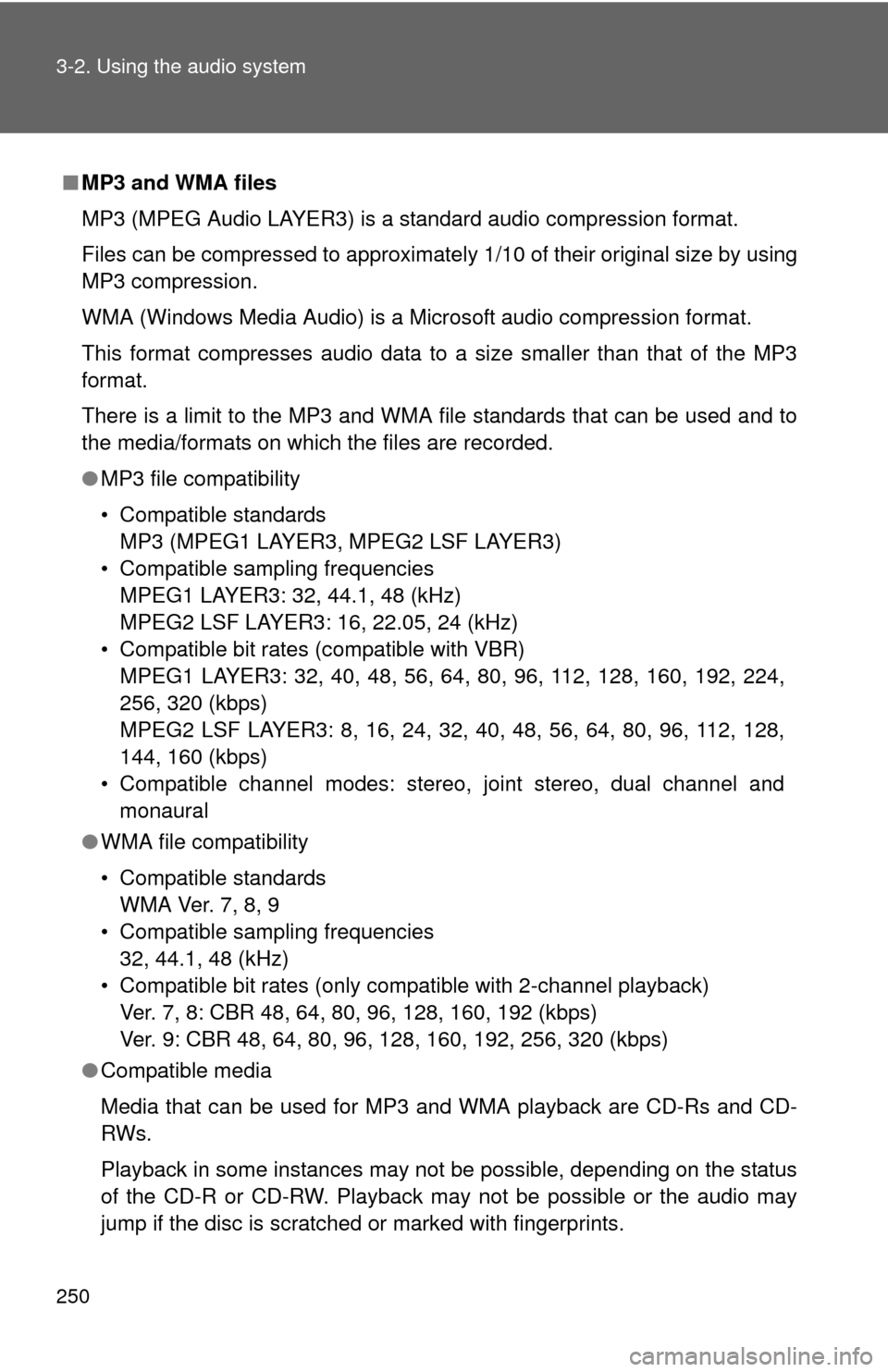
250 3-2. Using the audio system
Ō¢ĀMP3 and WMA files
MP3 (MPEG Audio LAYER3) is a standard audio compression format.
Files can be compressed to approximately 1/10 of their original size by using
MP3 compression.
WMA (Windows Media Audio) is a Microsoft audio compression format.
This format compresses audio data to a size smaller than that of the MP3
format.
There is a limit to the MP3 and WMA file standards that can be used and to
the media/formats on which the files are recorded.
ŌŚÅMP3 file compatibility
ŌĆó Compatible standards
MP3 (MPEG1 LAYER3, MPEG2 LSF LAYER3)
ŌĆó Compatible sampling frequencies MPEG1 LAYER3: 32, 44.1, 48 (kHz)
MPEG2 LSF LAYER3: 16, 22.05, 24 (kHz)
ŌĆó Compatible bit rates (compatible with VBR) MPEG1 LAYER3: 32, 40, 48, 56, 64, 80, 96, 112, 128, 160, 192, 224,
256, 320 (kbps)
MPEG2 LSF LAYER3: 8, 16, 24, 32, 40, 48, 56, 64, 80, 96, 112, 128,
144, 160 (kbps)
ŌĆó Compatible channel modes: stereo, joint stereo, dual channel and monaural
ŌŚÅ WMA file compatibility
ŌĆó Compatible standards
WMA Ver. 7, 8, 9
ŌĆó Compatible sampling frequencies 32, 44.1, 48 (kHz)
ŌĆó Compatible bit rates (only compatible with 2-channel playback) Ver. 7, 8: CBR 48, 64, 80, 96, 128, 160, 192 (kbps)
Ver. 9: CBR 48, 64, 80, 96, 128, 160, 192, 256, 320 (kbps)
ŌŚÅ Compatible media
Media that can be used for MP3 and WMA playback are CD-Rs and CD-
RWs.
Playback in some instances may not be possible, depending on the status
of the CD-R or CD-RW. Playback may not be possible or the audio may
jump if the disc is scratched or marked with fingerprints.